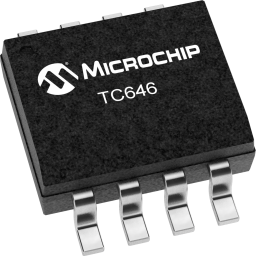
TC646VOA713
ActiveIC MOTOR DRIVER 3V-5.5V 8SOIC
Deep-Dive with AI
Search across all available documentation for this part.

TC646VOA713
ActiveIC MOTOR DRIVER 3V-5.5V 8SOIC
Technical Specifications
Parameters and characteristics commom to parts in this series
| Specification | TC646VOA713 | TC646 Series |
|---|---|---|
| Applications | - | Fan Controller |
| Function | - | Controller - Speed |
| Interface | - | Parallel |
| Motor Type - AC, DC | - | Brushless DC (BLDC) |
| Mounting Type | - | Surface Mount, Through Hole |
| null | - | |
| Operating Temperature | - | 85 °C |
| Operating Temperature | - | -40 - 0 °C |
| Output Configuration | - | Pre-Driver - Low Side |
| Package / Case | - | 8-MSOP, 8-TSSOP, 8-SOIC, 8-DIP |
| Package / Case | - | 0.118 in |
| Package / Case | - | 0.3 - 3 mm |
| Package / Case | - | 3.9 mm |
| Package / Case | - | 0.154 in |
| Package / Case | - | 7.62 mm |
| Supplier Device Package | - | 8-MSOP, 8-SOIC, 8-PDIP |
| Voltage - Supply | - | 5.5 V |
| Voltage - Supply | - | 3 V |
Pricing
Prices provided here are for design reference only. For realtime values and availability, please visit the distributors directly
| Distributor | Package | Quantity | $ | |
|---|---|---|---|---|
| Digikey | Tape & Reel (TR) | 3300 | $ 1.52 | |
| Microchip Direct | T/R | 1 | $ 1.98 | |
| 25 | $ 1.65 | |||
| 100 | $ 1.52 | |||
| 1000 | $ 1.44 | |||
| 5000 | $ 1.43 | |||
TC646 Series
IC MOTOR DRIVER 3V-5.5V 8MSOP
| Part | Operating Temperature [Max] | Operating Temperature [Min] | Applications | Package / Case | Package / Case [custom] | Package / Case | Motor Type - AC, DC | Supplier Device Package | Voltage - Supply [Max] | Voltage - Supply [Min] | Interface | Mounting Type | Function | Output Configuration | Package / Case [y] | Package / Case [x] | Package / Case |
|---|---|---|---|---|---|---|---|---|---|---|---|---|---|---|---|---|---|
Microchip Technology TC646BEUA | 85 °C | -40 °C | Fan Controller | 8-MSOP, 8-TSSOP | 0.118 in | 3 mm | Brushless DC (BLDC) | 8-MSOP | 5.5 V | 3 V | Parallel | Surface Mount | Controller - Speed | Pre-Driver - Low Side | |||
Microchip Technology TC646VOA713 | |||||||||||||||||
Microchip Technology TC646VUA | 85 C | 0 °C | Fan Controller | 8-MSOP, 8-TSSOP | 0.118 in | 3 mm | Brushless DC (BLDC) | 8-MSOP | 5.5 V | 3 V | Parallel | Surface Mount | Controller - Speed | Pre-Driver - Low Side | |||
Microchip Technology TC646EOA | 85 °C | -40 °C | Fan Controller | 8-SOIC | Brushless DC (BLDC) | 8-SOIC | 5.5 V | 3 V | Parallel | Surface Mount | Controller - Speed | Pre-Driver - Low Side | 3.9 mm | 0.154 in | |||
Microchip Technology TC646EOA | |||||||||||||||||
Microchip Technology TC646VUA | |||||||||||||||||
Microchip Technology TC646BEUA713 | |||||||||||||||||
Microchip Technology TC646BEOA | |||||||||||||||||
Microchip Technology TC646BEUA713 | 85 °C | -40 °C | Fan Controller | 8-MSOP, 8-TSSOP | 0.118 in | 3 mm | Brushless DC (BLDC) | 8-MSOP | 5.5 V | 3 V | Parallel | Surface Mount | Controller - Speed | Pre-Driver - Low Side | |||
Microchip Technology TC646BEOA | 85 °C | -40 °C | Fan Controller | 8-SOIC | Brushless DC (BLDC) | 8-SOIC | 5.5 V | 3 V | Parallel | Surface Mount | Controller - Speed | Pre-Driver - Low Side | 3.9 mm | 0.154 in |
Description
General part information
TC646 Series
The TC646B is a new version of the existing TC646 fan speed controller. This device is a switch mode fan speed controller, which incorporates a new fan auto restart function. Temperature proportional speed control is accomplished using pulse width modulation. A thermistor (or other voltage output temperature sensor) connected to the VIN input supplies the required control voltage of 1.20V to 2.60V (typical)
for 0% to 100% PWM duty cycle. The auto-shutdown speed is set by a simple resistor divider on the VAS input. An integrated Start-Up Timer ensures reliable fan motor start-up at turn-on, coming out of shutdown mode, auto-shutdown mode, or following a transient fault. A logic low applied to VIN, pin 1, causes fan shutdown.
The TC646B also features Microchip Technology's proprietary FanSense™ technology for increasing system reliability. In normal fan operation, a pulse train is present at SENSE, pin 5. A missing-pulse detector monitors this pin during fan operation. A stalled, open, or unconnected fan causes the TC646B device to turn the VOUT output on full (100% duty cycle). If the fan fault persists (a fan current pulse is not detected within a 32/F period), the FAULT output goes low. Even with the FAULT output low, the VOUT output is on full during the fan fault condition in order to try and restart the fan. The FAULT signal is also asserted if the PWM reaches 100% duty cycle, indicating that maximum cooling capability has been reached and a possible thermal runaway condition exists.
Documents
Technical documentation and resources


